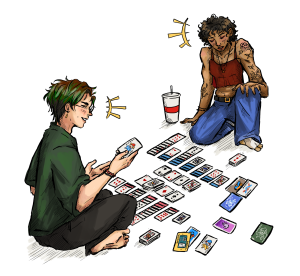Book Review: “Station Eleven” by Emily St. John Mandel shatters clichés
November 10, 2015
The line “because survival is insufficient” was taken from a 1999 Star Trek episode, but has a special place in Emily St. John Mandel’s 2014 novel “Station Eleven.” In addition to being tattooed on the arm of the main character Kirsten, it speaks to the story as a whole. In “Station Eleven,” Mandel ambitiously attempts to write about art in apocalypse–and even more remarkably, she succeeds.
The story unfolds fifteen years after the spread of a deadly flu that wiped out most of the population. It follows Kirsten as she travels by caravan with a nomadic Shakespearean troupe called “The Symphony” that performs for the scattered settlements around the Great Lakes.
The narrator jumps through time to tell the reader about before the pandemic, when Kirsten was a child actress. During a performance of “King Lear” the night before the outbreak, Kirsten watches as famous actor Arthur Leander dies from a heart attack on stage; the first act of violence she witnesses.
Arthur turns out to be a through-thread in the story, connecting many of the characters. The EMT that jumps onstage to perform CPR on him is an ex-paparazzo that used to take pictures of Arthur’s ex-wife, Miranda, to sell to tabloids. Miranda’s secret passion was creating a hand-drawn comic book about the fictional “Station Eleven” space station. Although Miranda died from the flu, her comic book survives and is found by Kristin. As Kristin reads, she notices how the story reflects the situation of the apocalypse in a twisted and distorted way.
Miranda’s comic book and the Shakespearean plays that The Symphony performs remind the world of humanity after the collapse of civilization, and the characters hold tightly to what they can find of art. A settlement living in an airport that Kirsten visits has created a “Museum of Civilization” including high-heeled shoes, polished car engines, and keyboards.
Full of dark suspense and masterfully-executed plot twists, “Station Eleven” leaves the reader disturbed without delving into the gory minutia transpiring at the beginning of civilization’s collapse.
To some readers, this may be an irrevocable omission. Indeed, there were times when I was frustrated with the missing explanations of mayhem and horror that I’ve come to expect. There are glimpses of the terrible violence, but the gritty details are left out, as are the particulars of survival. However, it is clear throughout that Mandel focuses on other things she deems more important. She centers her book on a question largely ignored in its genre: What happens to art? What becomes of culture?
“Station Eleven” is different from any post-apocalyptic novel I’ve read in the way it interprets what is important for its characters. Beautifully written, “Station Eleven” is a quiet, nostalgic story that focuses on what remains from the former world.
Remembering her childhood before the plague, Kirsten remarks, “The more you remember, the more you’ve lost.”





